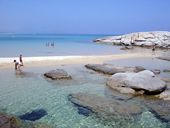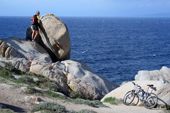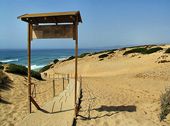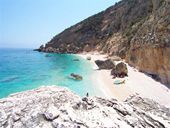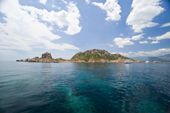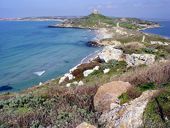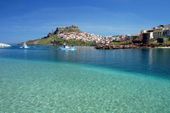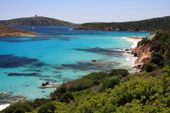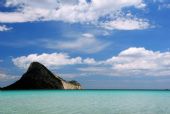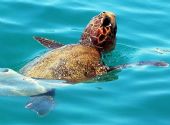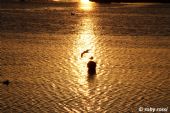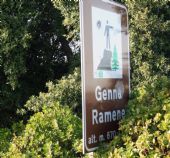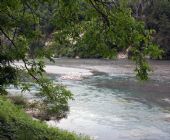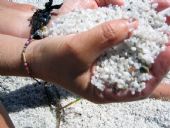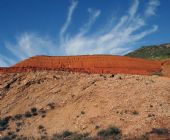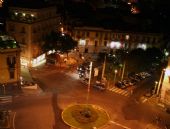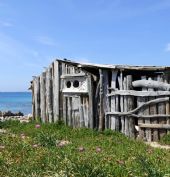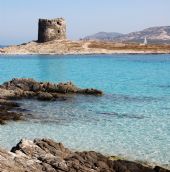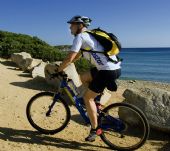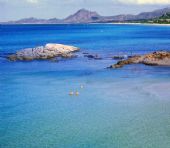
territory of the island of Sardinia
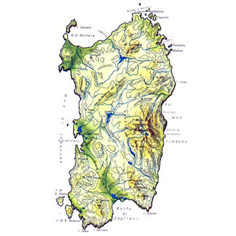
With an area about 24,000 sq km., Sardinia is the second largest island in the Mediterranean after Sicily, boasting a natural heritage among the most important in Europe and appreciated by tourists from around the world. An enchanted island, and interesting from several points of view: the sea, the vast hinterland and the character of its people, insular and strongly tied to the traditions of their homeland.
Autonomous region with special status, formed from the island of the same name and many other smaller islands, including La Maddalena, Asinara, Caprera, Sant'Antioco and San Pietro, Sardinia is wet east of the Tyrrhenian Sea, west of the Sea
Sardinia, to the south by the Mediterranean Sea to the north and is separated from Corsica by the Strait of Bonifacio. Its capital Cagliari and sudduvude 8 in tourist areas: Cagliari, Nuoro, Oristano, Sassari, Gallura, Ogliastra, Middle Campidano and Sulcis Iglesiente. Note to classical antiquity with the Latin name Sardinia, the region boasts a diverse coastal profile that extends for 1850 km. (Including smaller islands), almost a quarter of what the whole of Italy, with its cliffs, cliffs along the sea, deep coves, white beaches and sheltered bays.
The internal territory, although it is mostly made up of hilly areas, gives the visitor a strong impact mountainous, because of its uneven and fragmented. The findings, mostly of granitic and sedimentary, are made up of a series of mountain ranges (including those of Marghine Goceano, Gennargentu (with Supramontes), Limbara, Sulcis, dell'Iglesiente) culminating in 1,834 m. in Punta La Marmora of the Gennargentu Massif. In the south west, between Cagliari and Oristano, covers over 1,200 square kilometers. the flood plain of Campidano, the largest, while to the north, in Sassari, there is the Nura. At the mouth of the Great Plains are the coasts of greater extension where you can also see beautiful landscapes dune. The main rivers are predominantly torrential character and they are almost all dammed forming artificial basins: among the largest the Tirso (158 km.), The
Fluorescent (127 km.) And the Coghinas (123 km.); between the lower Rio Mannu, the Cedrino, the fear, the Smooth.
The only natural lake is the Baratz of Nura, while of considerable ecological importance are the various coastal ponds, prevalent in areas of Oristano and Cagliari. This rich variety of landscapes is important associations with the various species of flora and fauna that inhabit them. The vegetation is primarily a strong representation of oak, the most common tree in the region, in the species of oak, holm oak and cork oak, this latter from the Gallura Barbagia north to the plateau of Abbasanta and Oristano; in some intermediate zones of western Gennargentu is the presence of the chestnut; no shortage Finally residues of ancient forests of the Tertiary populated by badgers and holly. In coastal areas and in the Supramonte are juniper and olive trees,
while the expanses bushy myrtle, mastic, rock rose and strawberry tree form the rich Mediterranean vegetation.
The fauna, including numerous endemic species, with the presence of the Sardinian deer, mouflon, animal symbol of the island and many wild boars; among other mammals are the fox, marten, wild cat, the hare and the dormouse. Among the birds, the Eleonora's falcon, peregrine falcon, Bonelli's eagle and the golden eagle, the griffon vulture. In wetlands bird life includes, among others, the flamingo and the rare purple gallinule. The universe is populated by marine species
common in the Mediterranean and rarities like the tortoises and the famous monk seal, located in the caves of the east coast.
province of Cagliari routes
The Cagliari is the perfect synthesis of Sardinia, able to enhance those aspects that place it as one of the top destinations in world tourism with a coastline that stretches from the crystal waters of the Costa Rei to the sandy beaches of the South Coast, united by beautiful city of Cagliari ...territory of Olbia Tempio routes
the region of Sardinia most famous and popular which includes the magnificent stretch of sea that is the Costa Smeralda, an international tourist destination, while the hinterland reveals that recent history told by the pens, scattered in the countryside that characterize the area of Gallura ...territory of Sanluri Villacidro routes
The area of 1500 sq km. Enclosing a series of landscapes and natural emergencies that make the Middle Campidano one of the most extraordinary land of Sardinia, on all Piscinas dunes that stretch along the Costa Verde, the Giara and the site nuragico Su Nuraxi ...territory of Nuoro routes
The vacation in Nuoro has the strong taste of the traditions of Sardinia, which still pulsate here almost intact. The main asset of the area is in its natural environment, one of the green lungs of the Mediterranean, with the baronies and Barbagia that tell a hinterland extraordinary, magical, enchanting ...territory of Tortolì Lanusei routes
Ogliastra is a wild, inaccessible for long stretches, perhaps even more territory to explore, even more mysterious and, therefore, more charming with Arbatax, Tortoli, Gairloch and the entire coastal stretch where stretch wide sandy beaches alternating with red porphyry rocks ...territory of Oristano routes
A landscape mild, gentle in his reliefs, with lagoons and stretches of coast that free the mind, leaving rushing fantasies and dreams, an environment that assembles fascinating marine scenery surrounded by beautiful beaches, a wild cliffs that rise between the sky and the sea .. .territory of Sassari routes
a land rich in beauty and charm, capable of expressing points of absolute delight, from Alghero to Castelsardo, with the island of Asinara, one of the most fascinating destinations in Sardinia, then Valledoria where the mouth of Coghinas draws an environment unique and fabulous scenery ...territory of Carbonia Iglesias routes
one of the least attacked by tourism, which has well preserved its natural beauty, offering itself to the visitor and the traveler as a piece of Sardinia authentic and to be discovered, the Sulcis Iglesiente is a destination for fans travelers who love places "out route "...
- extraordinary landThe transparency of its sea, the beauty of its coast and an inland area of ??extraordinary charm, are only the frame of an island that is a destination among the top internationally...
- on the southeastern coast of the islandspotted at the beach in this little corner of paradise, in the municipality of Castiadas, along the southeastern coast of the island, not far from Villasimius ...
- an art that reflects the nature and the rural home of the Sardinian peoplecarving and woodworking as in the famous wooden masks, production of knives, coral workers, the watermark, cork, granite, and then weaving, embroidery and much more ...
- The first dates back to the seventh millennium BCbest known emblem of Sardinia is the dolmen, built by building civilizations nuragiche precisely, who settled on the island from 2500 BC about until a few decades before the Christian era ...
- Sardinia, a huge natural parkThe uniqueness of the Sardinian territory could be considered in its entirety, a huge park natural, despite the difficulties in reconciling the interests of environmental protection with those tourist economy ...
- Sardinia is populated by a rich variety of plants and animalsThis rich variety of landscapes is important associations with the various species of flora and fauna that inhabit them. The vegetation is primarily a strong representation of oak, the most common tree in the region ...
- the largest are the Tirso and Flumendosa and CoghinasThe main rivers are predominantly torrential character and they are almost all dammed forming artificial basins: among the largest the Tirso (158 km.), Flumendosa (127 km.) And the Coghinas (123 km.). ..
- between cliffs, smooth rocks, deep bays and long white sandy beachesThe region boasts a diverse coastal profile that stretches for 1850 km. (including smaller islands), almost a quarter of what the whole of Italy, with its cliffs, cliffs along the sea, deep coves, white beaches ...
- Sardinia has an uneven and fragmentedThe internal territory, although it is mostly made up of hilly areas, gives the visitor a strong impact mountainous, because of its uneven and fragmented. The findings, mostly of granitic and sedimentary ...
- images of the coast of Cagliari and its hinterlandPhotographs that tell the beauty of the capital city of Sardinia and its province. A journey from the sea to discover, including panoramic views of details, an area which is a tourist destination ...
- with the Sinai Peninsula and the island of Maldiventrethe western part of the island is that of the open sea, the infinite that opens before his eyes, the ancient history that recounts the island, in the ruins of Tharros, a pearl that embellishes extraordinary surroundings ...
- Castelsardo, Alghero and Stintino her pearlsin the northwestern part of Sardinia is a land rich in beauty and charm, capable of expressing points of absolute delight in its beaches, in his town, among the best known and Alghero Stintino that overlooks the island of Asinara
- for lovers of trekking and mountain bikingAmong the largest of the island, the park is spread inland of the province of Cagliari, affecting the towns of Castiadas, Villasimius and Muravera, going down to lap the coastline ...
- in the southernmost part of the beach of Costa ReiIts location and the alternation of rocks and small sandy coves, gives this stretch of coast image paradise, enriched by beautiful backdrops and the wrecks of Capo Ferrato ...
-
Search
-
Categories
- APP FAITA Sardegna
- HOLIDAY PACKAGES
- CAMPING VILLAGE Sardinia
- Where to eat
- TRANSPORT Sardinia
- BEACHES in Sardinia
- Tours in Sardinia
- KITCHEN traditional Sardinian
- WINES Sardinia
- SPIRITS of Sardinia
- EVENTS in Sardinia
- CORTES Apertas in Sardinia
- SPORT in Sardinia
- MAP Sardinia
- PHOTOS Sardinia
- VIDEO Sardinia
- Useful Numbers Sardinia
- DOGGIE BEACH in Sardinia
- Contact information
- archivio
-
Topics
- Camping e Village Sardinia
- Tourism in Sardinia
- resorts in Sardinia
- Sardinian beaches routes
- Specialties at the table
- South Coast Cagliari
- Costa Rei itinerari
- Ogliastra itinerari
- Nuoro e provincia itinerari
- Gallura itinerari
- Sassari e provincia itinerari
- Oristano e provincia itinerari
- Autunno in Barbagia 2013
- Aerei per la Sardegna
- Traghetti per la Sardegna
- Storia di Sardegna
- Feste e sagre della Sardegna
- Camping Village e Spiagge dog friendly
- Spiagge accessibili con l'amico cane






